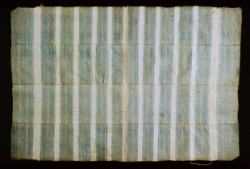|
Tags: aborigine | clothing | Tao | Yami
 The woven cloth of the Yami (Tao) tribe is simple in shape and form, yet highly unique among Taiwan’s indigenous tribes. Mostly only two colors are used, white and blue or white and black, and there are 18 weaving variations. Clothes for daily use were solid color. Clothes for formal occasions were made with a white background and blue stripes and a number of accessories were worn such as elaborate agate necklaces. As Lanyu, also known as Orchid Island, is warm all year round, men traditionally worn loincloths and women wore a chest apron and skirt. The woven cloth of the Yami (Tao) tribe is simple in shape and form, yet highly unique among Taiwan’s indigenous tribes. Mostly only two colors are used, white and blue or white and black, and there are 18 weaving variations. Clothes for daily use were solid color. Clothes for formal occasions were made with a white background and blue stripes and a number of accessories were worn such as elaborate agate necklaces. As Lanyu, also known as Orchid Island, is warm all year round, men traditionally worn loincloths and women wore a chest apron and skirt.
This type of shawl was worn by women. Women wore a short skirt and above that was a slanting piece of cloth called ayob amavakes. There was no difference in the shape or form of this cloth among women of different ages and marital statuses. Most shawls were made from four pieces of cloth that were sewn together and had vertical stripes in black or blue, as well as white stripes. In weaving formal attire for men or women, before the pieces of cloth were sewn together, it was necessary to perform certain rites that included the slaughtering of a goat or pig. It was thought that formal wear worn on the upper body possessed spiritual power and could withstand the blood of the slaughtered animal. Usually, black or blue stripes were arranged in even numbers (8, 10 or 12). During the funeral rites for a blood relative, a woman wore this shawl with the reverse side out. Men placed this cloth over their head with the reverse side out to symbolize mourning. The body of the deceased was wrapped in cloth that was tied with rope before the body was buried.
The same article of clothing could be worn in different ways, each of which had a different cultural meaning.
This shawl is 107 centimeters in length and 18 centimeters in width, and made from four pieces of woven cloth sown together with ramie thread horizontally along the long margins. The entire shawl has 12 lines of blue rhombuses that form 11 vertical stripes interspersed with white stripes. Along the left and right sides, at the bottom and top, are seams of 11 to 13 centimeters in length. Among them, there is one for which only the imprint remains and this imprint measures 12 centimeters.
This shawl was wrapped around the body and then tied at the upper and lower edges. If performing rites to drive out evil spirits or traditional dances, the lower hemline was folded upward to the waistband and tied there. Today, buttons have been substituted for the traditional ties. The warp is white and the weft consists of white and blue. The material is ramie. There are two types of patterns, rhombuses and squares.
Department of Graphic Communications and Digital Publishing, Shih Hsin University Digital archiving project of the Shung Ye Museum of Formosan Aborigines
|